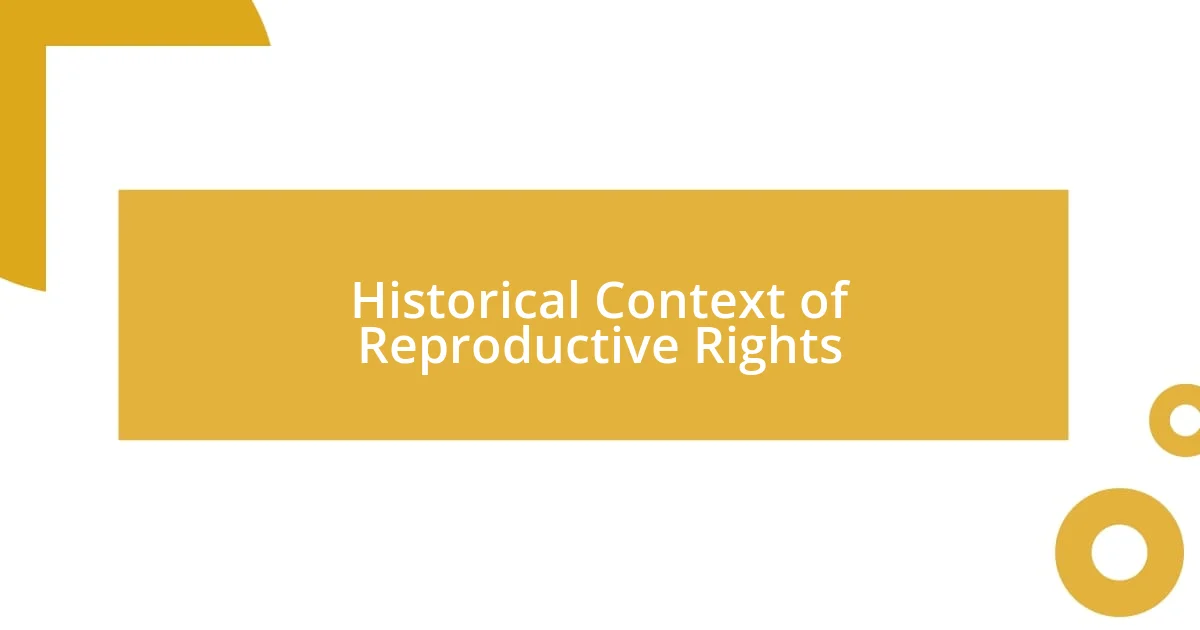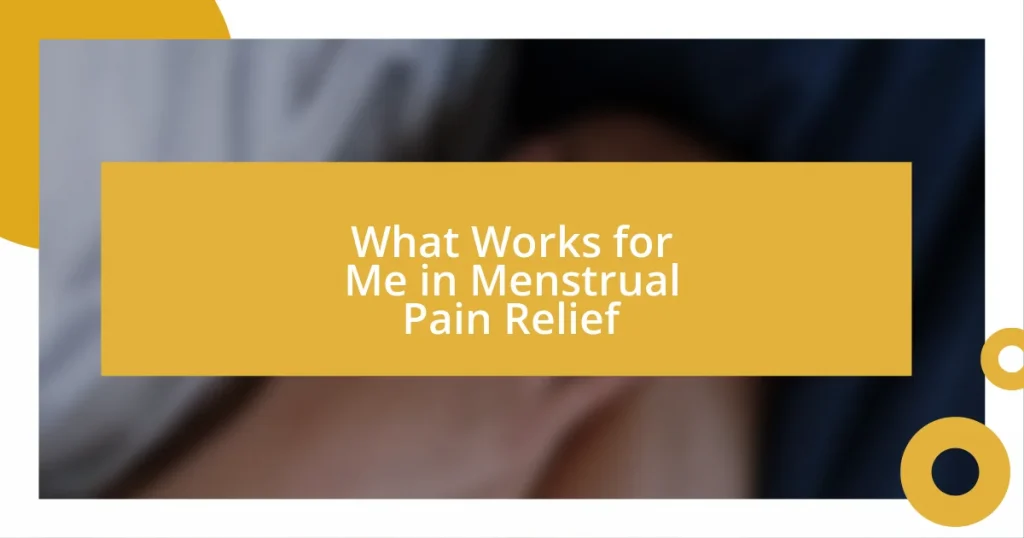Key takeaways:
- The historical fight for reproductive rights, particularly the suffragette movement, laid the groundwork for autonomy over women’s bodies, culminating in significant cases like Roe v. Wade (1973).
- Restrictive state-level legislation, especially following the overturning of Roe v. Wade, poses significant challenges to women’s access to reproductive health services.
- Education and advocacy, alongside engaging younger generations and utilizing technology, are crucial for fostering informed discussions and promoting reproductive rights in the future.

Understanding Reproductive Rights
Reproductive rights encompass the ability to make informed decisions about one’s body, which includes access to contraception, safe abortion, and comprehensive sexual education. I remember a friend who, during a college health class, shared her frustration about how misinformation and stigma cloud the conversation around these rights. It struck me then how crucial it is for individuals to receive accurate information, enabling them to advocate for their own health and choices.
It’s essential to acknowledge that reproductive rights are deeply intertwined with gender equality and overall health. In my experience volunteering for a women’s health organization, I witnessed firsthand how access to reproductive health services can uplift communities. It makes you wonder: what could be the ripple effect if everyone had consistent access to these resources?
Moreover, global perspectives on reproductive rights vary significantly, reflecting cultural, legal, and economic differences. I had the opportunity to travel abroad, and in talking with women from diverse backgrounds, I felt both empowered and alarmed by the stark contrast in their experiences with reproductive health. It left me questioning how these variances impact women’s lives on a fundamental level.

Historical Context of Reproductive Rights
The journey of reproductive rights is steeped in history, marked by pivotal moments that shaped the landscape we see today. For instance, the fight for women’s rights in the early 20th century laid the groundwork for later developments. I recall listening to a podcast that chronicled the suffragette movement, and it hit me how the push for the right to vote was intrinsically linked to women’s autonomy over their own bodies.
As these movements progressed, the landmark Roe v. Wade decision in 1973 became a focal point in the conversation about reproductive rights in the United States. Reflecting on my own understanding, I remember debating this case with classmates, highlighting both the legal and moral complexities surrounding it. It was an eye-opener to explore how legal precedents influence personal choices, often igniting fierce debates that echo through generations.
Looking globally, the evolution of reproductive rights varies widely, influenced by cultural, religious, and socio-economic factors. I once attended an international seminar where speakers shared their experiences advocating for reproductive health in their countries. Their stories revealed not only the struggles faced but also the victories achieved, making me realize how interconnected our experiences are, regardless of geographic boundaries.
| Key Milestone | Year |
|---|---|
| Suffragette Movement Beginnings | Late 19th – Early 20th Century |
| Roe v. Wade Decision | 1973 |
| International Conference on Population and Development | 1994 |
| Global Gag Rule Reinstatement | 2017 |

Key Legislation Impacting Reproductive Rights
The landscape of reproductive rights is significantly shaped by key legislation that influences access and equity. Reflecting on the recent surge in state-level laws following the overturning of Roe v. Wade, I find it important to share how these changes impact women’s lives daily. One particular legislative impact that stands out to me was the passage of the Women’s Health Protection Act, which aimed to protect abortion access nationwide. Discussions I had with friends about their fears regarding unwanted pregnancies brought the urgency of these laws to light—how they can genuinely alter the fate of women’s reproductive health.
Here are some pivotal laws that have sculpted the present framework surrounding reproductive rights:
- Roe v. Wade (1973): Established the constitutional right to abortion.
- Hyde Amendment (1976): Restricted federal funding for abortions, impacting low-income women.
- Title X Family Planning Program: Provides funding for reproductive health services, though it faced limitations under the Global Gag Rule.
- Dobbs v. Jackson Women’s Health Organization (2022): Overturned Roe v. Wade, leading to numerous state-level restrictions on abortion.
- The Women’s Health Protection Act (2021): Sought to codify the protections established by Roe, though it ultimately failed in Congress.
As I engaged in discussions about these pieces of legislation, I felt a pressing sense of responsibility. The stories I heard from women pleading for their reproductive rights reminded me that for many, these laws aren’t just abstract concepts; they are lifelines. Balancing legal frameworks with personal narratives truly highlights the complexity and urgency of advocating for reproductive justice.

Challenges to Reproductive Rights Today
One of the most pressing challenges to reproductive rights today is the wave of restrictive legislation sweeping across various states. Reflecting on conversations I’ve had with friends who work in reproductive health, I’ve seen firsthand the sheer anxiety that comes with navigating these changing laws. It makes me wonder: how do women in these environments feel empowered to make choices about their own bodies when the regulations seem to shift daily?
The stigmatization of reproductive health services creates an additional barrier. I remember attending a community meeting where a passionate advocate shared her story of seeking care but facing judgment and misinformation. Her experience resonated deeply with me; how many women silently bear the weight of similar struggles? The stigma surrounding not just abortion, but also contraception and prenatal care, hampers access to vital services, which can have profound long-term consequences.
Furthermore, access disparities fuel the challenges to reproductive rights. I was moved during a workshop when participants from various backgrounds shared how socio-economic status dramatically influences their reproductive choices. It’s alarming to think about how women in low-income areas often face obstacles that those in more affluent communities might never encounter. Are we acknowledging the full scope of these challenges when we discuss reproductive rights?

Resources for Educating Others
Providing resources to educate others about reproductive rights is essential in fostering informed discussions and advocating for change. I often find myself sharing insightful articles and research papers from organizations like the Guttmacher Institute or Planned Parenthood. These sources aren’t just informative; they provide a solid foundation of facts that challenge misconceptions and shine a light on the realities many women face.
In my experience, hosting community workshops makes a real difference. During one such event, I brought together a diverse group of people to discuss the impact of reproductive legislation. The conversations that emerged were eye-opening. Participants shared personal stories that created a deeper understanding of the topic. It’s incredible how a simple dialogue can empower others to become advocates in their own right, helping them feel equipped to speak about these issues with confidence.
Additionally, I always encourage sharing social media accounts and websites dedicated to reproductive rights. Following experts and activists often leads to rich content that can be shared and reshared, amplifying voices that must be heard. I remember scrolling through Twitter after a long day, coming across a thread detailing the struggles women face in accessing care. It was a strong reminder of the power of grassroots information in mobilizing support and educating those around us. Have you considered how social media could be a tool in your advocacy efforts? It’s worth exploring!

Future of Reproductive Rights Discussions
As I reflect on the future of reproductive rights discussions, I feel a sense of urgency around the importance of allyship and participation. I recall a recent roundtable discussion where individuals from different backgrounds came together to share their thoughts. It was powerful to see how diverse perspectives shaped our understanding of reproductive rights, emphasizing that everyone’s voice matters. How can we ensure that these conversations continue to be inclusive and engaging?
Looking ahead, I believe that technology will play a pivotal role in evolving reproductive rights discussions. I remember the thrill of participating in a virtual town hall meeting that connected advocates from across the country. The ability to share ideas and strategies in real-time was exhilarating! It made me consider: what innovative platforms can we create to bring more people into the fold? This dialogue can transcend geographical boundaries and join our voices in solidarity.
Moreover, I’m optimistic about younger generations taking the reins in advocating for reproductive rights. Just last week, I attended a local high school event where students passionately shared their stories regarding reproductive health education. Their energy is infectious. It left me wondering: how can we mentor and support these young advocates to ensure their momentum transforms into substantial change? Engaging them now will plant the seeds for a future where reproductive rights are respected and empowered by all.












